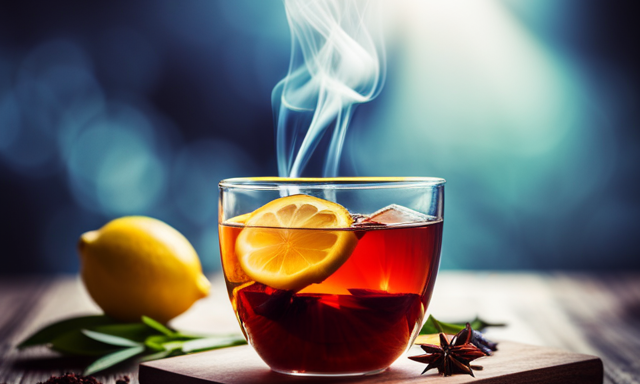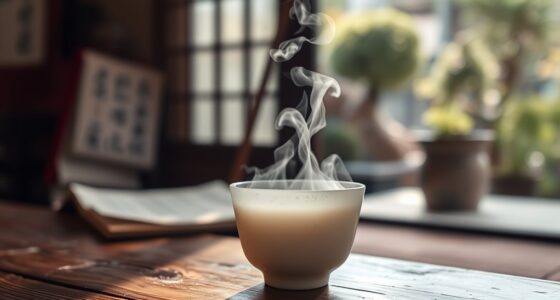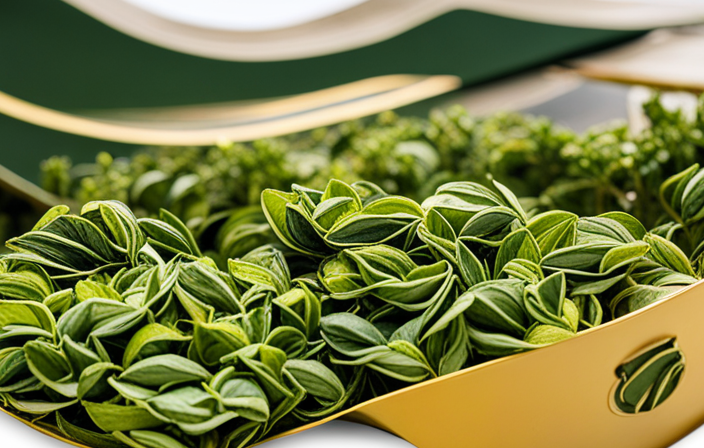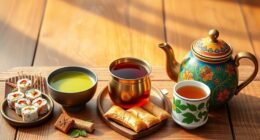As a tea lover, you might wonder: what sets each type of tea apart?
Well, let me tell you, my friend. Green, black, oolong, white, yellow, pu-erh, and herbal teas each have their own unique qualities that make them special.
From the delicate and refined nature of white tea to the exquisite flavor profile of yellow tea, there is a diverse world of tea waiting to be explored.
So, grab your favorite mug and join me on this journey of tea appreciation.
Key Takeaways
- Green tea has high antioxidant content, boosts metabolism, and aids in weight loss. It is brewed with water around 80°C and steeped for 2 minutes.
- Black tea has a rich flavor and pairs well with a variety of foods. It contains caffeine for a natural energy boost and is rich in antioxidants. Brewing techniques for black tea consider water temperature, tea-to-water ratio, steeping time, straining method, and serving temperature.
- Oolong tea has a range of taste profiles and boosts metabolism and aids in digestion. The flavors of oolong tea come from oxidation levels, roasting, and rolling methods. It has health benefits such as fighting free radicals, boosting metabolism, aiding in weight loss, and improving heart health.
- White tea has a delicate flavor with subtle floral and fruity notes. It is brewed with water around 80°C and steeped for 2-3 minutes. White tea contains antioxidants for overall health, can improve skin health, reduce the risk of premature aging, and supports a healthy immune system.
Green Tea: a Closer Look at Its Unique Characteristics
I love exploring the unique characteristics of green tea and discovering its benefits for my health. Green tea has been praised for its numerous health benefits, making it a popular choice among health-conscious individuals.
One of the main advantages of green tea is its high antioxidant content, which helps to protect the body against free radicals and reduce the risk of chronic diseases. Additionally, green tea has been shown to boost metabolism and aid in weight loss.
To fully enjoy the benefits of green tea, it’s essential to brew it correctly. The brewing technique plays a significant role in extracting the maximum flavor and health properties. For the perfect cup of green tea, use water that’s around 80°C and steep the leaves for about two minutes. This ensures a smooth and refreshing taste, along with all the health benefits green tea has to offer.
Black Tea: Unveiling the Distinctive Qualities
As a tea enthusiast, I’m captivated by the rich and complex flavor profiles that black tea has to offer. From the robust and malty notes of Assam to the delicate and floral nuances of Darjeeling, each sip is a journey of taste.
But it’s not just the flavors that make black tea special; it also boasts numerous health benefits, from its high antioxidant content to its potential heart-protective properties.
And when it comes to brewing techniques, the possibilities are endless, allowing us to tailor our black tea experience to our personal preferences.
Flavor Profiles of Black Tea
Black tea has a rich and robust flavor profile that includes notes of malt, caramel, and even hints of chocolate. It’s a versatile beverage that can be enjoyed on its own or with a splash of milk and sugar. When exploring black tea’s origins and comparing it to other types of tea, it becomes clear that black tea stands out for its bold and full-bodied taste.
Here are some unique qualities of black tea:
-
Smooth and malty flavor: Black tea has a distinct smoothness and a malty undertone that sets it apart from other teas.
-
Bold and robust: The flavor of black tea is bold and robust, making it a perfect choice for those who prefer stronger tasting beverages.
-
Versatile: Black tea can be enjoyed hot or cold, and it pairs well with a variety of foods.
-
Stimulating and energizing: Black tea contains caffeine, which provides a natural boost of energy.
-
Rich in antioxidants: Black tea is packed with antioxidants that promote overall health and well-being.
Health Benefits of Black Tea
Drinking black tea regularly can improve cardiovascular health and boost the immune system.
Black tea is rich in antioxidants called flavonoids, which have been shown to reduce the risk of heart disease by improving blood vessel function and reducing inflammation. These flavonoids also help in reducing the bad cholesterol levels in the body, thus promoting a healthy heart.
Additionally, black tea contains compounds called catechins, which have immune-boosting properties. These catechins help to strengthen the immune system, making it more effective at fighting off infections and diseases.
Black tea also contains caffeine, which can provide a natural energy boost and improve mental alertness.
Brewing Techniques for Black Tea
I usually prefer steeping two teaspoons of black tea leaves for five minutes, but sometimes I like to experiment with longer brew times to bring out different flavors. Different brewing methods and optimal steeping times can greatly influence the taste and aroma of black tea.
Here are five factors to consider when brewing black tea:
- Water temperature: Using water that’s too hot can result in a bitter taste, while water that isn’t hot enough may not extract the full flavor of the tea leaves.
- Tea-to-water ratio: Adjusting the amount of tea leaves to water can create a stronger or milder brew.
- Steeping time: Longer steeping times can lead to a more robust and full-bodied flavor, while shorter steeping times can result in a lighter and more delicate taste.
- Straining method: Using a tea infuser or strainer can prevent any residue from ending up in your cup.
- Serving temperature: Enjoying black tea hot or iced can provide different sensory experiences.
Oolong Tea: Exploring Its Special Features
As a tea enthusiast, I’ve always been captivated by the unique beauty of oolong tea. Its special features lie not only in its exquisite taste profile, which ranges from floral and fruity to toasty and nutty, but also in its numerous health benefits.
Oolong tea is known to boost metabolism, aid in digestion, and promote overall well-being.
Oolong’s Taste Profile
Usually, I find oolong tea’s taste profile to be a delightful balance between the boldness of black tea and the subtlety of green tea. Oolong tea varieties can offer a wide range of flavors, each with its own unique characteristics.
Here are some examples:
- Tie Guan Yin: Known for its floral aroma and smooth, buttery taste.
- Da Hong Pao: Renowned for its rich and roasted flavor with hints of chocolate and caramel.
- Ali Shan: Offers a delicate, creamy taste with floral notes.
- Oriental Beauty: A sweet and fruity tea with a honey-like flavor.
- Jin Xuan: Boasts a creamy and milky taste, reminiscent of buttered popcorn.
These different flavors arise from the various oolong tea processing techniques, such as oxidation levels, roasting, and rolling methods. Understanding these techniques can help one appreciate the complexity and depth of oolong teas.
Transitioning into the next section, let’s explore the health benefits of oolong tea.
Health Benefits of Oolong
Drinking oolong tea can provide numerous health benefits, such as boosting metabolism and reducing the risk of heart disease.
Oolong tea, a traditional Chinese tea, is known for its unique taste and aroma. It falls between black and green tea in terms of oxidation, resulting in a diverse range of flavors and health benefits.
Oolong tea contains polyphenols, which are powerful antioxidants that can help fight against free radicals and reduce the risk of chronic diseases. It also contains caffeine and catechins, which can boost metabolism and aid in weight loss.
Moreover, oolong tea has been shown to improve heart health by reducing cholesterol levels and lowering blood pressure.
With its various varieties and delightful taste, oolong tea isn’t only a beverage but also a natural remedy for maintaining a healthy lifestyle.
White Tea: Understanding Its Delicate and Refined Nature
I just learned about the delicate and refined nature of white tea. It’s truly a tea that embodies elegance and sophistication. Here are some key points to understand about white tea:
-
Delicate Flavor: White tea has a subtle and delicate flavor profile. It offers a light and refreshing taste with subtle floral and fruity notes.
-
Brewing Techniques: To fully appreciate the delicate flavors of white tea, it’s important to use lower water temperatures and shorter steeping times. This allows the flavors to gently infuse without becoming overpowering.
-
Health Benefits: Like other types of tea, white tea is known for its health benefits. It’s rich in antioxidants, which help protect the body against free radicals and support overall well-being.
-
Gentle Caffeine: White tea contains less caffeine than other teas, making it a great choice for those who want a gentle pick-me-up without the jitters.
-
Versatility: White tea can be enjoyed on its own or paired with light and subtle dishes. Its delicate flavors make it a versatile option for both hot and iced tea preparations.
Understanding white tea and its delicate flavor and brewing techniques allows us to fully appreciate its elegance. Exploring the health benefits of white tea adds to its appeal, making it a wonderful choice for tea enthusiasts looking to serve others with a refined and sophisticated beverage.
Yellow Tea: Discovering Its Exquisite Flavor Profile
Sometimes, yellow tea surprises with its exquisite flavor profile that combines the freshness of green tea and the mellow sweetness of black tea. Exploring yellow tea’s rich history, I’ve come to appreciate its unique characteristics and the art of brewing it.
Yellow tea originated in China during the Tang Dynasty and was reserved for the emperor’s use. Its delicate and complex production process involves withering, steaming, and oxidation, giving it a distinct flavor.
To brew yellow tea, one must use water at a lower temperature than other teas and steep it for a shorter time to avoid bitterness. The result is a smooth and balanced cup of tea that offers a refreshing aroma and a subtle, lingering sweetness.
Understanding the art of brewing yellow tea allows us to fully appreciate its rich history and exquisite flavor.
Pu-erh Tea and Herbal Tea: Exploring the Unconventional and Diverse World
Exploring the unconventional and diverse world of pu-erh tea and herbal tea, I’ve discovered the unique flavors and health benefits they offer. These teas aren’t just your ordinary cup of tea; they’re a world of possibilities waiting to be explored.
Here are some of the reasons why pu-erh tea and herbal tea are so special:
-
Unusual blends: Pu-erh tea and herbal tea offer a wide range of blends that aren’t commonly found in other types of tea. From exotic fruits to aromatic spices, there’s a blend for every taste preference.
-
Medicinal properties: Both pu-erh tea and herbal tea are known for their medicinal properties. These teas are often used in traditional medicine to help with digestion, boost the immune system, and promote overall well-being.
-
Variety of flavors: Whether you prefer a bold and earthy taste or a light and refreshing flavor, pu-erh tea and herbal tea have something for everyone. From floral notes to citrusy undertones, each cup is a delightful experience.
-
Customizable options: With pu-erh tea and herbal tea, you have the freedom to create your own unique blend. You can mix and match different herbs and flavors to create a tea that’s tailored to your personal preferences.
-
Natural and healthy: Unlike some other beverages, pu-erh tea and herbal tea are natural and healthy choices. They’re free from artificial additives and are packed with antioxidants and other beneficial compounds that can support your overall health and well-being.
Frequently Asked Questions
How Is the Caffeine Content in Different Types of Tea Compared to Coffee?
When comparing the caffeine content in different types of tea to coffee, it’s interesting to note that while coffee generally contains more caffeine, the amount in tea can vary depending on the type.
For example, black tea tends to have higher caffeine levels compared to green or white tea. However, despite its lower caffeine content, tea still provides a subtle energy boost without the jitters associated with coffee.
It’s important to consider the impact of caffeine on health and find the right balance that works for you.
What Are the Health Benefits Associated With Drinking Different Types of Tea?
When it comes to the health benefits of tea, different types have unique effects on our well-being. Whether it’s green tea with its antioxidant properties, black tea for cardiovascular health, or herbal teas for relaxation, each one offers something special.
Tea is a natural source of hydration and can support our immune system. So, no matter what type you choose, you can enjoy a delicious beverage while taking care of your health.
Can Tea Be Used for Cooking or Baking? if So, Which Types of Tea Work Best?
Tea isn’t only great for drinking, but it can also be used in cocktails and as an ingredient in desserts. When it comes to cooking or baking, certain types of tea work best.
For instance, green tea adds a refreshing flavor to ice cream or cakes, while earl grey tea brings a unique floral note to custards or cookies. Experimenting with different teas can elevate your culinary creations and introduce a whole new world of flavors.
Are There Any Cultural or Historical Significances Attached to Different Types of Tea?
Tea holds immense cultural significance and historical importance. It has been an integral part of various cultures and traditions for centuries. Each type of tea carries unique flavors, aromas, and health benefits that have been cherished by different communities around the world.
From the delicate and refined taste of green tea in East Asia to the bold and robust flavors of black tea in the West, tea has a rich tapestry of stories and customs woven into its leaves.
How Does the Processing Method Affect the Taste and Aroma of Different Types of Tea?
When it comes to tea, the processing method is key in determining its taste and aroma. Different types of tea undergo various processes, such as oxidation, fermentation, and roasting, which significantly impact their flavor profiles.
These methods bring out the unique characteristics of each tea, enhancing their taste and aroma. From the delicate floral notes of white tea to the bold and robust flavors of black tea, the processing method plays a vital role in making each type of tea truly special and distinct.
Conclusion
In conclusion, each type of tea offers a unique and special experience that caters to different tastes and preferences. Despite any initial doubts, exploring the diverse world of tea allows us to discover new flavors and aromas that can enhance our daily lives.
So, why not indulge in the richness of green, black, oolong, white, yellow, pu-erh, and herbal teas? Embrace the opportunity to embark on a delightful journey that will awaken your senses and provide a comforting respite from the everyday hustle and bustle.










